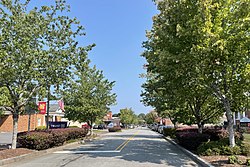Mount Holly, North Carolina | |
|---|---|
 Downtown Mount Holly | |
 Location of Mount Holly, North Carolina | |
| Coordinates: 35°18′51″N81°00′28″W / 35.31417°N 81.00778°W | |
| Country | |
| State | |
| County | Gaston |
| Incorporated | March 11, 1879 |
| Government | |
| • Mayor | David Moore |
| Area | |
• Total | 11.30 sq mi (29.26 km2) |
| • Land | 11.22 sq mi (29.05 km2) |
| • Water | 0.081 sq mi (0.21 km2) |
| Elevation | 627 ft (191 m) |
| Population (2020) | |
• Total | 17,703 |
| • Density | 1,578.5/sq mi (609.46/km2) |
| Time zone | UTC-5 (Eastern (EST)) |
| • Summer (DST) | UTC-4 (Eastern (EDT)) |
| ZIP code | 28120, 28012 |
| Area codes | 704, 980 |
| FIPS code | 37-44960 [3] |
| GNIS feature ID | 2404319 [2] |
| Website | www |
Mount Holly is a small suburban city in northeastern Gaston County, North Carolina, United States. The city is situated just west of the Catawba River, north of Interstate 85, south of North Carolina State Highway 16. The population was 17,703 at the 2020 census, [4] up from 13,656 in 2010.






